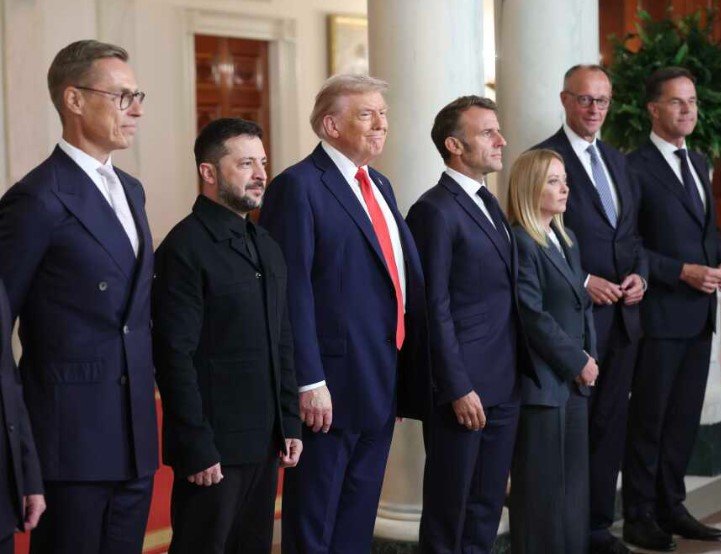US President Donald Trump is set to meet with officials from several Muslim-majority countries today to discuss a new proposal aimed at ending the ongoing war in Gaza. The meeting, happening on the sidelines of the UN General Assembly in New York, focuses on post-war governance, hostage releases, and regional stability amid nearly two years of conflict.
This gathering comes as Trump seeks buy-in from key players like Saudi Arabia, the United Arab Emirates, Qatar, Egypt, Jordan, Turkey, Indonesia, and Pakistan. Sources indicate the US plan involves an Israeli withdrawal, Arab-led peacekeeping forces, and rebuilding efforts without Hamas involvement. The push follows recent global outrage over civilian suffering in Gaza and stalled ceasefire talks.
Details of the High-Stakes Meeting
Trump’s administration has been working on this initiative for months, with input from former UK Prime Minister Tony Blair. The meeting aims to secure commitments for troops and funding to stabilize Gaza after the fighting ends.
White House officials describe it as a critical step toward peace. They hope to gain feedback and support from these nations, which have strong ties to the region. The discussion will also touch on freeing remaining hostages held by Hamas since the October 7, 2023 attack.

An unnamed US official noted that the plan outlines the only viable path forward. Arab sources confirm Trump wants regional backing to push the proposal ahead. This comes amid Israel’s fresh military push in Gaza City, where clashes have intensified.
The timing aligns with Trump’s UN address, where he plans to highlight American strength and critique global institutions. Later, he will host a reception for world leaders and meet Turkish President Recep Tayyip Erdogan.
Key Elements of the US Proposal
The proposal centers on ending the war through structured steps. It calls for an Israeli pullout once security is assured by Arab forces. Governance would exclude Hamas, with a focus on rebuilding infrastructure destroyed in the conflict.
Funding from Arab nations would support reconstruction and humanitarian aid. This includes programs for displaced Palestinians and economic development in Gaza.
Here are the main components of the plan:
- Israeli withdrawal from Gaza after hostages are freed and Hamas is sidelined.
- Deployment of multinational Arab peacekeeping troops to maintain order.
- Exclusion of Hamas from any future government to prevent further violence.
- International funding for rebuilding homes, schools, and hospitals.
- Long-term security guarantees to address Israeli concerns.
Experts say this could reduce tensions, but challenges remain. Israel has expressed reservations about parts involving the Palestinian Authority.
Recent data shows over 65,000 Palestinians reported killed or missing in Gaza, per local health officials. Israel claims it has eliminated more than 22,000 combatants while minimizing civilian harm.
Reactions from Regional Players
Leaders from the invited countries have mixed views. Some see it as a chance for peace, while others worry about committing troops without clear guarantees.
Saudi Arabia and the UAE have shown interest in normalization with Israel, but insist on progress toward a two-state solution. Egypt and Jordan, bordering Gaza and the West Bank, emphasize humanitarian needs.
Turkey and Qatar, with ties to Hamas, may push for inclusive talks. Indonesia and Pakistan add broader Muslim world perspectives.
Public sentiment varies. Social media posts reflect concerns over past US ideas, like a proposed takeover of Gaza earlier this year, which drew criticism as potential ethnic cleansing.
In February 2025, Trump floated displacing Palestinians for redevelopment, but the idea lost steam amid global backlash. Now, the focus shifts to collaborative governance.
Update on Hostages and Ceasefire Efforts
Hostage negotiations remain a flashpoint. Hamas recently sent a letter to Trump requesting a 60-day truce in exchange for releasing half of the 48 remaining captives.
This echoes a May proposal by US envoy Steve Witkoff, which Netanyahu supported but Hamas altered with new demands. Families of hostages rallied in Jerusalem, urging a deal.
The IDF reports 20 hostages may still be alive, with bodies of 26 confirmed dead held in Gaza. Efforts continue amid accusations of starvation and civilian harm in the enclave.
A two-month ceasefire earlier in Trump’s term ended in March due to disagreements. Officials hope this meeting revives talks.
| Hostage Statistics | Details |
|---|---|
| Total Abducted on October 7, 2023 | 251 |
| Remaining in Gaza | 48 (including bodies) |
| Believed Alive | 20 |
| Confirmed Dead (Bodies Held) | 26 |
| Released or Rescued So Far | Over 100 through deals and operations |
Broader Implications for Middle East Peace
This meeting occurs against a backdrop of shifting diplomacy. Several nations, including France, the UK, Canada, and Australia, recently recognized a Palestinian state, drawing Israeli criticism as rewarding terror.
Israel vows to expand settlements in response, while Arab states warn against West Bank annexation. The UN summit highlighted a two-state solution as essential for peace.
Trump’s approach contrasts with his earlier promise of a quick war end. Eight months into his term, resolution eludes, but this plan could leverage US influence.
Logical reasoning suggests success depends on balancing Israeli security with Palestinian rights. Related events, like Syria-Israel talks on border security, show potential for wider stability.
Analysts predict if adopted, the proposal could reshape the region, reducing Iran’s influence through groups like Hamas and Hezbollah.
Challenges and Path Forward
Implementing the plan faces hurdles. Israel insists on Hamas’s total defeat, while Palestinians demand sovereignty. Funding and troop commitments are uncertain.
Global pressure mounts with images of emaciated civilians sparking outrage. Rights groups call for accountability on all sides.
Trump’s meeting with Netanyahu next week may clarify Israel’s stance. The US aims to mediate without direct military involvement.
As the Jewish New Year begins, hopes for peace mix with ongoing strife. Readers, share your thoughts on this development in the comments below and spread the word to keep the conversation going.
